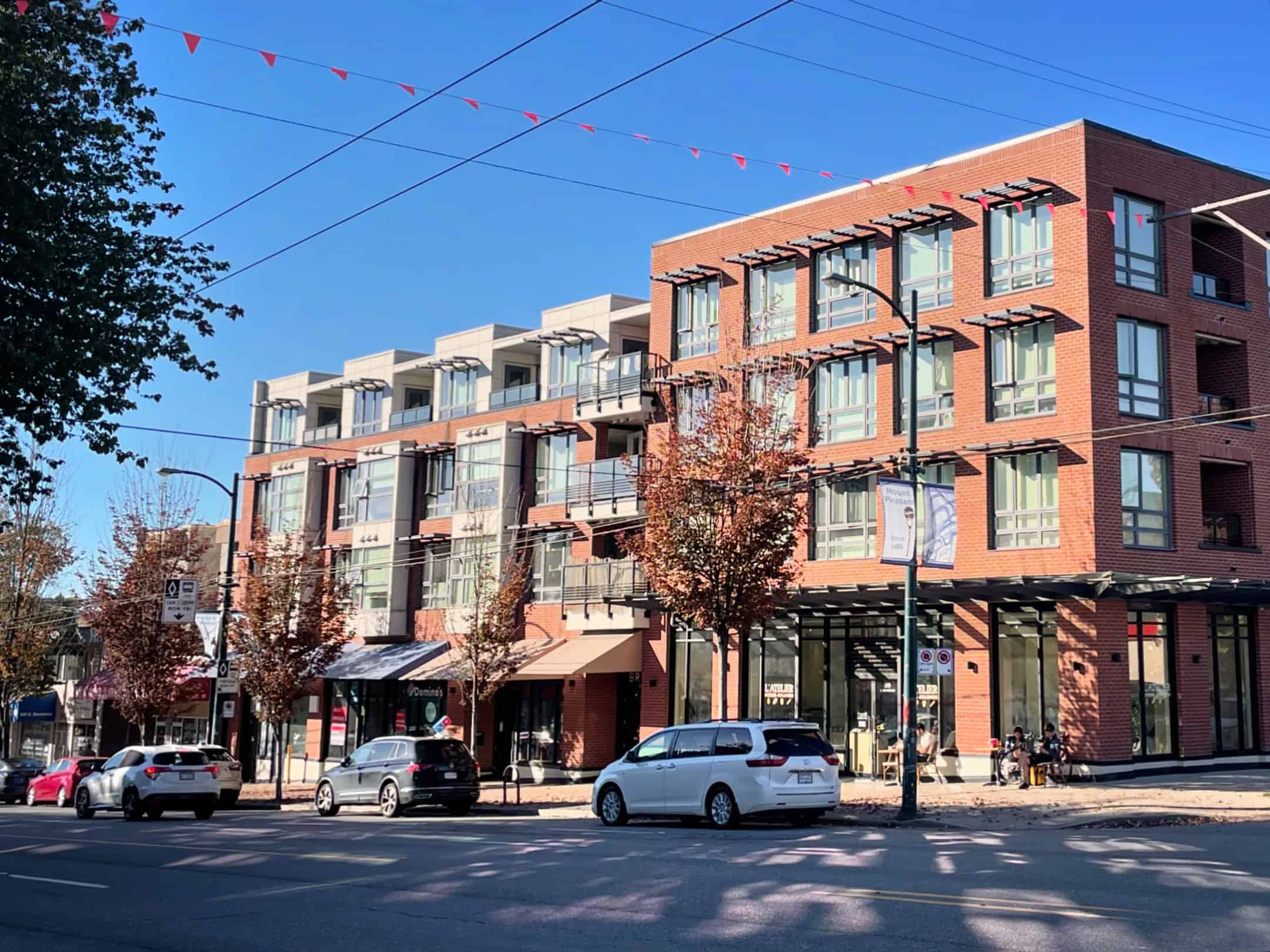Takeaways
- Vancouver is the epicenter of British Columbia’s housing crisis and shortage, where apartments are still not allowed on more than three-quarters of the city’s residential land.
- This persistent exclusionary zoning deepens the housing shortage and hurts Vancouverites and British Columbians—especially renters—in several ways, driving ever worse inequality, sprawl, pollution, and costs.
- Advocates are organizing effective pro-housing campaigns, and the province’s government has recently shown a willingness to push back on cities applying exclusionary zoning.
- Unfortunately, the measures taken don’t yet meet the severity of the shortage, and the upcoming election could roll back even the important progress made.
Editor’s note: This article was originally published by Policy Note.
Vancouver is the epicenter of British Columbia’s housing crisis and shortage. So why does the city still ban new apartment buildings on most of its residential land, reserving it exclusively for low-density housing?
While there have been small steps towards reforming single-detached zoning in Vancouver in recent years, apartments are still not allowed on more than three-quarters of the city’s residential land. Much the same is true in other big, expensive cities in BC and across North America.
Under this decades-old zoning regime, sometimes referred to as the “grand bargain,” apartments are permitted only in relatively narrow segments of a city. Apartment construction is largely confined to busy roads and areas with older apartments where working-class and poorer folks live, while the wealthiest single-detached housing areas are left largely untouched to avoid provoking NIMBY backlash.
The results of this “grand bargain” are perhaps easiest to see from above, as in the image below from the housing advocacy group, Vancouver Area Neighbours Association. While Vancouver may conjure images of glassy downtown skyscrapers, the reality is that most of the city’s land area is taken up by single-detached houses, the most expensive and land-intensive form of housing.

The BC government has recently shown a willingness to incrementally push back on cities applying exclusionary zoning (more on this below), but as yet, it hasn’t been prepared to overturn widespread apartment bans. Persistent exclusionary zoning in cities like Vancouver is deepening the housing shortage and inflicting damage on Vancouverites and British Columbians—especially renters—in several ways.
Seven ways the apartment ban hurts renters and perpetuates the housing shortage
1. It blocks new homes on most of cities’ land
First, the apartment ban is suppressing the creation of badly needed new housing in huge parts of our cities. The Canada Mortgage and Housing Corporation estimates that British Columbia needs to build 610,000 more homes by 2030 above current trends, consistent with findings of independent analysts. Housing shortages hurt the most vulnerable, while adding new housing helps reduce upward pressure on rents.
We can’t address those shortages while blocking apartment creation on the vast majority of cities’ residential land.
2. It drives renter displacement and the loss of older, more affordable apartments
Second, the apartment ban in single-detached areas is driving displacement of tenants in existing apartment areas. Under the status quo, with apartments blocked in the vast detached-housing zones of our cities, development is steered instead towards places where apartment buildings are already located, leading to the demolition of older, lower-cost apartments. Burnaby notoriously saw widespread displacement of renters in this manner near Metrotown, and other cities have seen similar patterns of development.
It doesn’t have to be this way: new apartments could be built instead in nearby single-detached areas if cities would allow it.
3. It balloons the costs and risks of building new homes, including for affordable housing developers
Third, exclusionary zoning increases both the costs of new housing and the risk that uncertainty and delay prevent construction altogether. In limited areas where apartment housing is allowed (through an unpredictable discretionary rezoning process), developers of new housing—non-market1 and market alike—have to compete for scarce parcels, driving up land purchase prices. As a result, even well before a rezoning process, exclusionary zoning artificially increases land prices for the sites where apartments are allowed by keeping them scarce.
For nonprofits trying to build affordable housing, the cost and risk of the rezoning process itself can jeopardize project viability. Higher costs for non-market housing translate directly into higher rents, undermining affordability. In Vancouver, nonprofit housing developers estimate that a rezoning process can easily cost them $500,000 to $1 million, including required pre-development expenditures and fees.
4. It restricts neighborhood choices and segregates apartments to busy, polluted roads
Fourth, by suppressing apartment creation in wealthier areas, exclusionary zoning robs people of the option to live in the areas they choose. Historically, this has been a conscious effort of city officials to ensure certain neighbourhoods are reserved for “the crème de la crème,” as one resident of a wealthy Vancouver area put it.
Instead, residents of most new apartments are forced to live in the restricted areas where building apartments is allowed: on noisy, polluted arterial roads, harming their health and safety. Indeed, one “community vision” document in Vancouver praised this practice of confining new apartments to busy roads because they help “shield, to some extent, adjacent single family homes from the noise of arterial traffic” and “leave large areas of single family unchanged.” Steering development to arterial roads also puts a target on small businesses that may be displaced from low-cost commercial spaces on these streets.
5. It drives sprawl, long commutes, and air pollution
Fifth, when cities like Vancouver block apartments on so much of their land, it pushes people out of the city and spurs more car-dependent sprawl in outlying areas. This means more commuter misery, higher household transportation costs, and increased climate pollution. Indeed, a growing body of research points to ending these exclusionary residential land use policies as a critical climate solution.
6. Its resulting sprawl costs more for public infrastructure
Sixth, channeling development into suburban sprawl increases public infrastructure costs. It’s much more expensive to provide roads, sewers, schools, transit, and other public goods in sprawling suburban developments than in more compact communities. As a recent Metro Vancouver report confirms, “Higher density development forms are associated with lower per capita municipal expenditures for streets and highways, sewer, water, and solid waste.”
The continued imposition of the apartment ban makes addressing long-standing infrastructure deficits more difficult and expensive across Metro Vancouver.
Within cities like Vancouver, denser neighborhoods also contribute proportionally more to the city tax base than do areas with sprawling detached housing, even though providing public infrastructure to the latter is more expensive. Allowing more apartments in low-density areas would increase and broaden the local tax base and help fund important infrastructure investments that have been long neglected.
7. It widens inequalities and hurts economic growth by limiting people’s opportunities
Seventh, excluding people from large high-productivity cities like Vancouver by blocking apartments means excluding them from job opportunities and higher wages, which hurts economic growth and increases inequality. In short, apartment bans make everyone poorer.
Advocacy, provincial policy, and the election
Advocates are increasingly pushing back and shining a light on exclusionary zoning and its harms. The group Abundant Housing Vancouver regularly organizes walking tours to help people see how exclusionary zoning affects cities on the ground, including in a recent tour of the ultra-wealthy Shaughnessy neighborhood. The Vancouver Area Neighbours Association has helped organize support for new rental and non-market apartments in areas like the wealthy West Point Grey neighborhood, where the voices of opponents of new housing usually dominate.
With a provincial election fast approaching, where does provincial housing policy fit in this equation? British Columbia is head-and-shoulders above any other Canadian province in taking action on housing policy, and the provincial government deserves credit for that. But the action still doesn’t match the scale of the housing shortage in many important dimensions, including on zoning reform.
In a step forward, BC legislation now requires cities to allow small multiplexes in areas formerly reserved for single-detached houses. However, this falls far short of allowing apartment buildings, and cities like Vancouver are implementing the multiplex policy in a highly restrictive way that will limit its benefits.
The provincial government is also pushing cities to allow apartment buildings within 800 meters of transit hubs like Skytrain stations, which include areas still dominated by single-detached houses. But there are too many ways for cities to wriggle out of these requirements, which apply to limited areas.
These steps forward urgently need to be expanded, yet the main opposition BC Conservative party strongly opposed even these limited steps on reforming single-detached zoning. In an interview earlier this year, leader John Rustad called the BC government’s reforms “crazy” and promised to “repeal all of that,” despite saying he would (somehow) increase housing supply. The BC Green Party voted against the legislation allowing multiplexes in single-detached areas but in favor of allowing larger apartment buildings near transit hubs.
Ending exclusionary zoning once and for all
In a housing crisis and shortage, public policy should ensure that land where apartments are permitted is plentiful, not scarce and expensive. Yet long-standing zoning and land use policies are geared to do exactly the opposite, preventing the construction of multi-family homes in the places that need it most.
To end the apartment ban, at a minimum, expensive cities like Vancouver should allow at least six-story rental apartments by right—without discretionary site-by-site rezonings—anywhere that you can currently build a multimillion-dollar detached house (that is, almost anywhere). Additional density should be permitted for non-market housing specifically, ensuring public and nonprofit providers are in a strong position to acquire land when competing with private developers.
If cities like Vancouver are willing to finally end the apartment ban on their own, that would be welcome, but their records are not encouraging. There is a strong democratic case for provincial action on zoning.
To be clear, zoning reform isn’t a silver bullet for the housing crisis. There are many other key pieces of the puzzle, including a massive increase in public investment in non-market housing, taxing the wealthiest landowners, and strong tenant protections. But any serious effort to tackle the housing crisis and shortage must bring the apartment ban to an end.
Cracks in the edifice of exclusionary zoning have appeared in recent years, yet it remains in force on the vast majority of land in our cities. There is no way out of the housing crisis—or towards a large build-out of non-market and rental homes on the scale BC needs—without finally ending the apartment ban.


